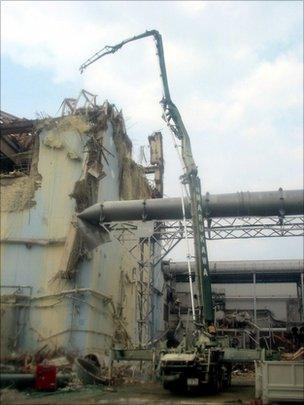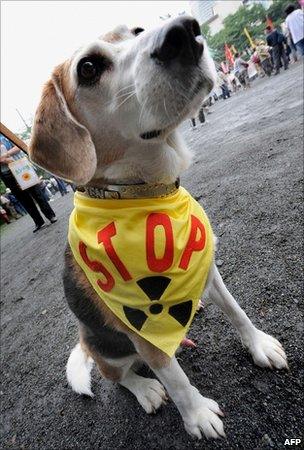Nuclear reviews leave open questions
- Published
- comments

The report makes recommendations for avoiding future Fukushimas - but are they enough?
In a burst of activity on Monday, the International Atomic Energy Authority (IAEA), external despatched the two potentially exciting documents of its week-long ministerial meeting, external into the public domain.
This is the meeting where IAEA member governments decide what changes they want to make to international regulation of nuclear industries, among other things.
And in the wake of the biggest nuclear accident for 25 years, at Japan's Fukushima Daiichi power station, this was clearly one where major shake-ups were possible.
The most likely candidate for change was the regime of international inspection, which is currently very light-touch.
In the run-up to the meeting, German and Swiss ministers alarmed by the proximity of French and Czech reactors to their borders said that governments should have the right to see safety assessments compiled by neighbouring states.
And in his opening speech to the IAEA assembly, its chief Yukiya Amano suggested that countries should have to open their doors to inspectors sent by the IAEA on spot-check missions.
To no-one's great surprise, neither option proved palatable to governments conscious of the near total sovereignty they retain over nuclear safety.
Instead, the Ministerial Declaration, external issued on Monday "recognises" that nuclear accidents can have international consequences, talks of increasing co-operation between governments and regulators, and "underlines the benefits of strengthened and high quality independent international safety expert assessments".
In fact, the declaration's only hostage to fortune is that it recognises "the need for a global nuclear liability regime that addresses the concerns of all states that might be affected by a nuclear accident with a view to providing appropriate compensation for nuclear damage".
Otherwise, there is nothing that cannot be interpreted in such as weak form as to indicate "business as usual".

Yukiya Amano wants random testing of nuclear facilities... but who else does?
Some of this will be clarified in the coming weeks, as the declaration also charges Mr Amano with preparing a "draft action plan".
However, in a clause likely to dismay some observers, it also recognises "the responsibility of the nuclear industry and operators in the implementation of nuclear safety measures..."
Given that criticism of Japan's nuclear regulation has honed in on a "cosy" relationship between industry and government, does this look like a tough new dawn where regulators will be rigorous, demanding and completely independent as they wield their whip hands?
The IAEA meeting also took delivery of a report on the Fukushima accident, external, compiled by an international fact-finding mission led by the UK's chief nuclear inspector Mike Weightman.
Among the things it clarifies (as did a Japanese government report, external issued a few weeks ago) is that meltdown in the reactors operating at the time of the 11 March Tohoku earthquake was much quicker and more severe than had been apparent at the time.
Modelling suggests that in Reactor 1, for example, coolant levels fell so rapidly that "the top of active fuel was reached about three hours after the plant [electrical power] trip.
"The core was completely uncovered two hours later. Core damage is calculated to have begun four hours after the trip and a majority of the fuel in the central region of the core was melted at 5.3 hours after the trip.
"At 14.3 hours after the trip, the core was completely damaged with a central molten pool and at 15 hours after the trip, all fuel had slumped to the bottom of the vessel."

Protests have dogged the nuclear industry in much of Europe, and further afield
A similar picture is given for the other reactors.
As we've known for a while, the Fukushima accident was the consequence of a sequence of events that serially put things like electrical power systems, cooling, personnel and instrumentation out of action.
But if you had to pick one key event, it would be the tsunami which, at 14m high, was nearly three times higher than the plant was designed to withstand.
The IAEA report's key recommendation on this: "Plant layout should be based on maintaining a 'dry site concept', where practicable..."
The final two words might arouse some surprise.
If having a power station become very wet indeed can cause such huge social and economic upheaval as we're seeing now in Japan, you might conclude that putting a "dry site concept" in place must be made practicable - non-negotiable, not merely optional.
The importance of the next couple of years for the nuclear industry and its regulation cannot be overstated.
The Russian delegate's speech to the IAEA meeting, for example, made clear that nuclear power will continue in his country.
He also made a powerful case for the development of reactors with passive safety systems - a technological approach to preventing future accidents.
Ideas do exist for reactors that do not generate weaponisable plutonium, that do not produce long-term waste, that are passively safe.
Where, though, is the support for turning these concepts into reality, rather than plumping for more of the same Pressurised Water and Boiling Water Reactors - albeit enhanced from the designs of Fukushima, Chernobyl and Three Mile Island - that come with all the baggage of the past?
When nations declare an end to the nuclear age, as Germany and Switzerland have, markets for extremely expensive pieces of kit disappear.
And with every market that closes, margins in the ones remaining tighten.
If people are not reassured that the industry is effectively regulated or is using the best technological ideas available, what is to make them support retention or expansion?